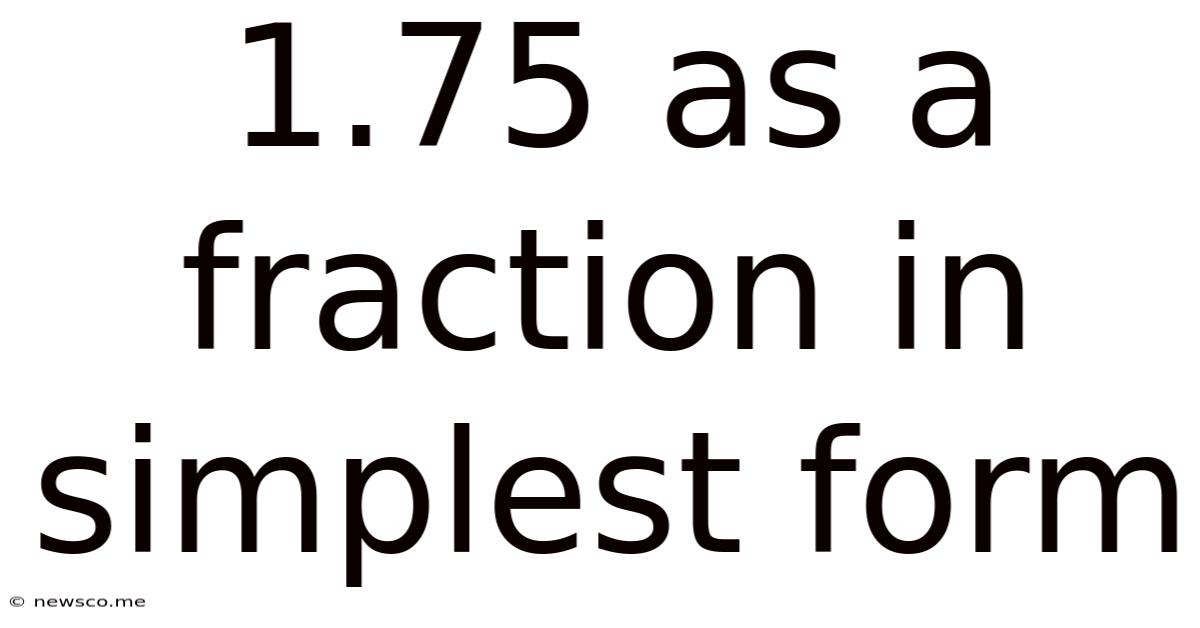1.75 As A Fraction In Simplest Form
News Co
Mar 19, 2025 · 4 min read

Table of Contents
1.75 as a Fraction in Simplest Form: A Comprehensive Guide
Converting decimals to fractions might seem daunting at first, but with a clear understanding of the process, it becomes straightforward. This comprehensive guide will delve into converting the decimal 1.75 into its simplest fractional form, explaining each step in detail and providing additional examples to solidify your understanding. We'll also explore the broader context of decimal-to-fraction conversions and their applications in various fields.
Understanding Decimal Places and Fractions
Before we begin, let's refresh our understanding of decimal places and their relationship to fractions. Decimals represent parts of a whole number using a base-ten system. The digits to the right of the decimal point represent tenths, hundredths, thousandths, and so on. For example:
- 0.1 represents one-tenth (1/10)
- 0.01 represents one-hundredth (1/100)
- 0.001 represents one-thousandth (1/1000)
Fractions, on the other hand, represent parts of a whole using a numerator (the top number) and a denominator (the bottom number). The denominator indicates the number of equal parts the whole is divided into, while the numerator indicates how many of those parts are being considered.
Converting 1.75 to a Fraction: Step-by-Step
Let's break down the conversion of 1.75 into a fraction step-by-step:
Step 1: Write the decimal as a fraction over 1.
This is the foundational step. We write 1.75 as a fraction with 1 as the denominator:
1.75/1
Step 2: Eliminate the decimal point by multiplying the numerator and denominator by a power of 10.
Since 1.75 has two digits after the decimal point, we multiply both the numerator and the denominator by 100 (10 raised to the power of 2):
(1.75 x 100) / (1 x 100) = 175/100
Step 3: Simplify the fraction.
This involves finding the greatest common divisor (GCD) of the numerator (175) and the denominator (100) and dividing both by it. The GCD is the largest number that divides both 175 and 100 without leaving a remainder. In this case, the GCD of 175 and 100 is 25.
Dividing both the numerator and denominator by 25:
175 ÷ 25 = 7 100 ÷ 25 = 4
Therefore, the simplified fraction is:
7/4
This is the simplest form because 7 and 4 share no common divisors other than 1.
Understanding the Result: Improper Fractions and Mixed Numbers
The fraction 7/4 is an improper fraction because the numerator (7) is larger than the denominator (4). Improper fractions can be converted into mixed numbers, which combine a whole number and a proper fraction.
To convert 7/4 into a mixed number, we divide the numerator (7) by the denominator (4):
7 ÷ 4 = 1 with a remainder of 3
This means that 7/4 is equal to 1 whole and 3/4. Therefore, the mixed number representation of 1.75 is:
1 ¾
Practical Applications of Decimal to Fraction Conversions
The ability to convert decimals to fractions is crucial in various fields:
-
Cooking and Baking: Recipes often require precise measurements, and converting decimal measurements (e.g., 2.25 cups) to fractions (2 ¼ cups) ensures accuracy.
-
Construction and Engineering: Precise measurements are essential in construction and engineering projects. Converting decimals to fractions simplifies calculations and ensures accuracy in blueprints and designs.
-
Finance: Working with percentages and interest rates often requires converting decimals to fractions for calculations involving compound interest, loan amortization, and other financial computations.
-
Science and Mathematics: In scientific and mathematical applications, working with fractions can be simpler than using decimals, especially when dealing with ratios and proportions.
Further Examples: Mastering Decimal to Fraction Conversions
Let's solidify your understanding with a few more examples:
Example 1: Converting 0.625 to a fraction:
- Write as a fraction over 1: 0.625/1
- Multiply by 1000 (three decimal places): 625/1000
- Find the GCD (125): 625 ÷ 125 = 5; 1000 ÷ 125 = 8
- Simplified fraction: 5/8
Example 2: Converting 2.3 to a fraction:
- Write as a fraction over 1: 2.3/1
- Multiply by 10 (one decimal place): 23/10
- This fraction is already in its simplest form, but we can convert it to a mixed number: 2 3/10
Example 3: Converting 0.12 to a fraction:
- Write as a fraction over 1: 0.12/1
- Multiply by 100 (two decimal places): 12/100
- Find the GCD (4): 12 ÷ 4 = 3; 100 ÷ 4 = 25
- Simplified fraction: 3/25
Advanced Considerations: Recurring Decimals
Recurring decimals, like 0.333... (one-third) present a slightly different challenge. These require a different approach which involves solving an equation. While beyond the scope of this specific guide focused on 1.75, understanding this aspect is crucial for a complete understanding of decimal-to-fraction conversions.
Conclusion: Mastering Fractions Enhances Numerical Proficiency
Converting decimals to fractions is a fundamental skill with wide-ranging applications. Mastering this skill enhances your overall numerical proficiency, enabling you to tackle more complex mathematical problems with greater confidence and accuracy. By understanding the steps involved and practicing with various examples, you'll become proficient in this important aspect of mathematics. Remember to always simplify your fractions to their lowest terms for the most efficient representation of the numerical value.
Latest Posts
Related Post
Thank you for visiting our website which covers about 1.75 As A Fraction In Simplest Form . We hope the information provided has been useful to you. Feel free to contact us if you have any questions or need further assistance. See you next time and don't miss to bookmark.